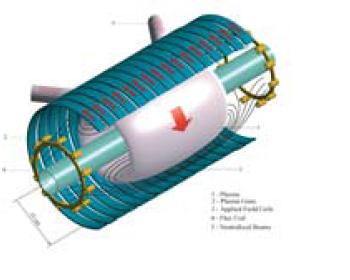Nuclear Fusion On a Scale People Can Appreciate
Small scale nuclear fusion startups are approaching the problem of fusion energy from several different directions. This glorious lack of consensus allows human ingenuity to test many promising technologies at a relatively low cost. New Scientist offers a small look at 3 small fusion startups (free registration is required to read the article at NS):
Brian Wang also takes a look at the NS article
Special Encore: A Gallery of Small Fusion Startups
Bussard IEC Fusion
Bussard inertial electrostatic confinement fusion (EMC2 Fusion) involves an electrostatic plasma confinement to achieve fusion. The history and development of the concept is explained in a video reached via the link above. The Bussard IEC has been financed almost entirely by the US Navy. EMC2 is based near Santa Fe, New Mexico.
Dense Plasma Focus Fusion
Lawrenceville Plasma Physics is based in New Jersey. The dense plasma focus approach uses a special pulsing "spark plug" to ionise a gas, and to form a plasmoid "pinch," with the emission of high energy photons, ions, and fusion neutrons.
HyperV
Hyper V Technologies utilises a spherical array of mini railguns to accelerate plasma beams into a central target of deuterium or deuterium-tritium, to achieve fusion (hopefully).
TriAlpha
TriAlpha is an Irvine, California venture, which has been fairly successful in the venture capital game. TriAlpha is a bit secretive with non-investors, but you can read their patent for yourselves. The concept seems to involve the highly sophisticated evolution from an earlier colliding beam fusion approach.General Fusion
General Fusion is a small startup headquartered near Vancouver, BC. The compression of plasma to achieve fusion is accomplished by a coordinated spherical plasma compression, using pneumatics and advanced switching.
Helion
Helion Energy is located in Redmond, Washington. It is based on a principle of "colliding plasmas," and like all the rest of the small fusion approaches, it is a long shot.
The Redmond device, dubbed the Fusion Engine, is the brainchild of a company called Helion Energy, and relies on a very different method of establishing and confining plasmas known as a field-reversed configuration. Discovered at the US Naval Research Laboratory in Washington DC in 1960, this process involves accelerating two small, compact balls of plasma into one another at a speed of hundreds of kilometres a second. The conditions created by the collision should, in theory, be sufficient to force the nuclei together, heat them and ignite fusion.
...In a peer-reviewed paper published in April this year, Helion researchers show how they used the technique to smash two plasmas together and achieve a temperature of 25 million degrees. That's still well below what is needed to ignite fusion, but the team also published calculations showing that ignition - and even break-even - should be possible in a device just three times the size of their prototype (Nuclear Fusion, vol 51, p 053008).
...Also pursuing the dream is the Canadian firm General Fusion based in Burnaby, British Columbia, using a method called magnetised plasma fusion. This set-up also emerged from the US Naval Research Laboratory, this time in the late 1970s. It involves igniting fusion in a plasma violently compressed within a cavity created in a spinning sphere of liquid metal.
...Tri Alpha Energy, a secretive California-based company, is believed to have raised $90 million for its variant of the field-reversed technique; among its investors is Microsoft co-founder Paul Allen. In a rare public communication a year ago, Tri Alpha researchers showed how they had collided two plasma balls at a temperature over 5 million degrees and held them together for up to 2 milliseconds (Physical Review Letters, vol 105, p 045003). Tri Alpha says it will produce a working commercial reactor some time between 2015 and 2020 - possibly before ITER fires up for the first time.... _Much more information and background at NS
Brian Wang also takes a look at the NS article
Special Encore:
Bussard inertial electrostatic confinement fusion (EMC2 Fusion) involves an electrostatic plasma confinement to achieve fusion. The history and development of the concept is explained in a video reached via the link above. The Bussard IEC has been financed almost entirely by the US Navy. EMC2 is based near Santa Fe, New Mexico.
Lawrenceville Plasma Physics is based in New Jersey. The dense plasma focus approach uses a special pulsing "spark plug" to ionise a gas, and to form a plasmoid "pinch," with the emission of high energy photons, ions, and fusion neutrons.
Hyper V Technologies utilises a spherical array of mini railguns to accelerate plasma beams into a central target of deuterium or deuterium-tritium, to achieve fusion (hopefully).
TriAlpha is an Irvine, California venture, which has been fairly successful in the venture capital game. TriAlpha is a bit secretive with non-investors, but you can read their patent for yourselves. The concept seems to involve the highly sophisticated evolution from an earlier colliding beam fusion approach.
General Fusion is a small startup headquartered near Vancouver, BC. The compression of plasma to achieve fusion is accomplished by a coordinated spherical plasma compression, using pneumatics and advanced switching.
Helion Energy is located in Redmond, Washington. It is based on a principle of "colliding plasmas," and like all the rest of the small fusion approaches, it is a long shot.
Labels: fusion







0 Comments:
Post a Comment
Subscribe to Post Comments [Atom]
<< Home